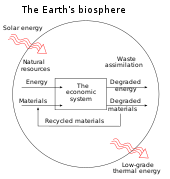지속가능한 경제복지 지수
Index of Sustainable Economic Welfare이 글은 어떤 관점에서는 균형이 맞지 않을 수 있다. (2013년 5월) |
| 다음에 대한 시리즈 일부 |
| 생태경제학 |
|---|
지속가능경제복지지수(ISWE)는 국민계정제도(SNA)의 주요 거시경제지표인 국내총생산(GDP)을 대체하려는 경제지표다. 단순히 GDP와 같은 모든 지출을 합산하기 보다는, 소비자 지출은 소득분배, 공해 및 기타 지속 불가능한 비용과 관련된 비용 등의 요인에 의해 균형을 이룬다. 실제 진행률 지표(GPI)와 유사하다.
지속가능한 경제복지 지수(ISWE)는 다음과 같은 공식으로 대략 정의된다.
ISWE = 개인소비
+ 공공 비용 비사용 지출
- 민간 방위비
+ 자본 형성
+ 국내 노동력의 서비스
- 환경 저하 비용
- 자연자본 감가상각
역사
GDP는 국민 복지의 척도는 말할 것도 없고 국민 복지의 척도로서도 오도하는 것이지만,[1] 경제 정책 입안자들은 흔히 정반대로 생각하지만, 국민 복지의 척도로도 오도하는 것이다. 이 문제는 이미 1970년대 초 대부분의[citation needed] 산업화된 국가의 실용적인 경제 정책에서 명백해졌다. The most famous examples of this development are the MEW index developed by William Nordhaus and James Tobin in their Measure of Economic Welfare (MEW) in 1972, the Japanese Net National Welfare (NNW) indicator in 1973, the Economic Aspects of Welfare index (EAW) index of Zolatas in 1981, the ISEW indicator of Daly and Cobb in 1989 and the UN's hu1990년[citation needed] 인간개발지수(HDI). 이들은 모두 신고전주의 복지경제에 바탕을 두고 있으며 국민계정제도(SNA)를 출발점으로 삼고 있다. 이러한 모든 접근법의 기본 개념은 통화 관점에서 종합 매크로인디케이터를 산출하기 위해 긍정적이고 부정적인 비시장 상품을 포함하는 것이다.
1950년부터 1977년까지 미국에게 적용된 EAW 지수는 사회 복지의 경제적 측면은 산업적으로 성숙하고 부유한[citation needed] 사회의 경제성장의 축소된 기능임을 보여주었다. 시간이 지남에 따라 사회 복지의 증가율은 GDP의 상응하는 증가율보다 작으며, 감소하고[citation needed] 있다. EAW/GDP 비율의 탄력성이 0에 도달하면, 경제 복지는 최대의 가치를 얻게 될 것이다. 그 점을 넘어서면 GDP의 추가 증가는 경제 복지의 절대적 감소로 이어질 것이다.
ISWE는 원래 1989년에 선도적인 생태경제학자 및 정상국가 이론가 헤르만 댈리와 신학자 존 B에 의해 개발되었다. 콥, 하지만 나중에 그들은 ISWE의[citation needed] 정의에 몇 개의 다른 "비용"을 추가하기 시작했다. 이 이후의 작업은 또 다른 거시경제 지표인 GPI(진정진행지표)를 초래했다. 지속가능성 측정을 참조하라. GPI는 ISWE의 연장선으로 사회의 진정한 진보를 강조하고 특히 복지와 경제의 생태적 지속가능성을 감시하고자 한다. ISWE와 GPI는 GDP가 경제적 산출물을 하나의 수치로 요약하는 논리에 따라 단일 수치로 경제복지를 요약한다. 경제 문제 외에도 통화적인 측면에서 사회, 환경 문제가 포함된다.
Trend of ISEW in the United States
The calculation of the ISEW in the United States from 1950 to 1986 was done by Cobb and Daly in 1989. The results reveal that the increase in economic welfare of an average American has stabilised after the 1970s although the economy, measured by GDP, has continued to grow. According to Cobb and Daly's calculations the external effects of production and the inequity of income distribution are the main reasons for this development in which an increase in production does not necessarily lead to an increase in welfare.
Other countries and regions to calculate ISEW
Besides the USA there have been at least seven other countries or regions which have compiled the ISEW, namely the UK (Jackson & Marks 1994), Germany (Diefenbacher 1994), The Netherlands (Rosenberg & Oegema 1995), Austria (Stockhammer et al. 1995), British Columbia (Gustavson & Lonergan 1994), Sweden (Jackson & Stymne 1996), Chile (Castaneda 1999), Finland (Hoffrén 2001), Poland (Gil & Śleszyński 2003), Belgium (Bleys, 2008) and Flanders (Bleys & Van der Slycken, 2019).
Progress of the Finnish ISEW
The calculation of the ISEW for Finland has been done by Dr. Jukka Hoffrén at Statistics Finland in 2001 [1]. Today the time period covered is extended to years from 1945 to 2010. According to results sustainable economic welfare rose steadily in the 1970s and early 1980s, but has since declined and stabilised. One of the underlying reasons for this development was effective income distribution which apportioned evenly the welfare derived from increased production. In the mid-1980s income disparities started to grow again, flows of capital (investments) abroad increased and environmental hazards escalated, resulting in a decline in the weighted personal consumption.
Major contributors to Finnish ISEW in 2000 (FIM billion, rp)
Weighted personal consumption + 467.8
Household work + 82.8
Other positive contributions + 21.7
Long-term environmental damage - 228.0
환경 악화 - 192,5
ISWE + 151,8
참고 항목
지수
기타
참조
- ^ Wuppertal Institute. "Alternatives to GDP for Measuring Progress" (PDF). Wuppertal Institute. Retrieved 6 January 2017.
- 블리스, B. (2008) 지속가능한 경제복지 지수 변경 제안: 벨기에에 지원서. 생태경제학 641, 741-751.
- 블리스, B, and Van der Slicken, J. (2019) De Index voor Duurzame Economicische Welvaart (ISWE) voor Vlaanderen, 1990-2017. MIRA, MIRA/2019/04, Universititeit Gent, MIRA/Millieumaatschappij의 Studie Uitgevoerd. 웹: https://biblio.ugent.be/publication/8641018/file/8641020
- Daly, H. & Cobb, J. (1989), For the Common Good. 보스턴 비컨 프레스
- Delang, C.O.와 Y.H. (2015) 경제성을 넘어서는 복지 측정: 홍콩과 싱가포르의 진정한 발전. 런던: 루트리지, 256쪽
- Diefenbacher, H. (1994년), "독일의 지속 가능한 경제 복지의 지수" (C.) Cobb & J. Cobb(eds), The Green National Product, University of Americas Press.
- Gil, S. & Elsziński J.(2003), "폴란드를 위한 지속 가능한 경제 복지 지수", 지속가능 개발, 제11권, 제1호, 2003년, (47-55년)
- 해밀턴 C. (1999년) "진정한 진행률 지표: 호주를 형성하는 방법론적 발전과 결과", 생태경제학, 30권, 페이지 13–28
- 호프렌 J.(2001) "국민경제에서 복지세대의 환경효율 측정 핀란드의 사례." 핀란드의 통계. 연구 보고서 233. 헬싱키 107-109페이지
- 잭슨, T, 마크, N, 랄스, S, 스트림네, S(1997) "영국 1950-1996년 지속 가능한 경제 복지 지수", 환경 전략 센터, 서리, 길드포드 대학
- 잭슨, T. 마크스, N. (2002) "진행량 측정", 신경제재단과 지구의 친구들, 런던
- 잭슨, T, 맥브라이드, N, 마크 N, 압달라, S.(2006~2007)."지역 진행률 측정: 런던 신경제재단 '영국의 지속가능한 경제복지 지역지표 개발'
- 노다우스, W.와 토빈, J.(1972) 성장은 구식인가. 뉴욕 컬럼비아 대학 출판부



